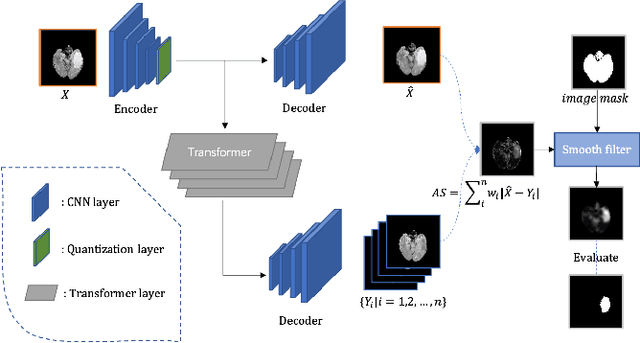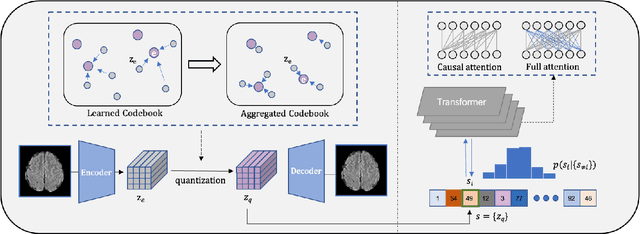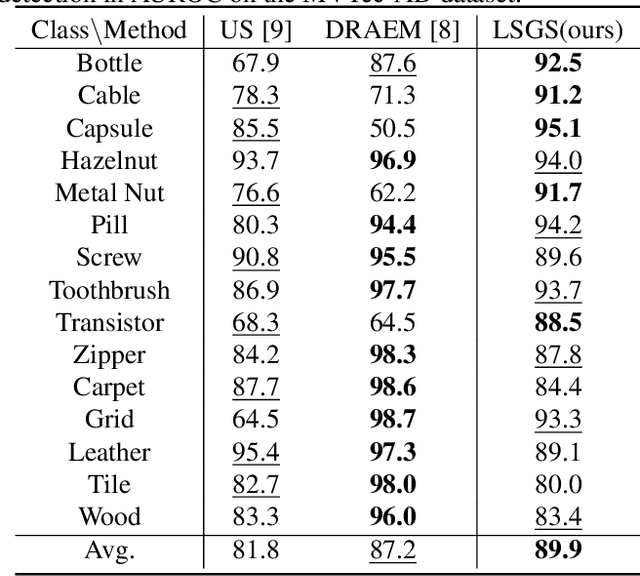Chengxiao Luo
Unsupervised Anomaly Detection with Local-Sensitive VQVAE and Global-Sensitive Transformers
Mar 29, 2023



Abstract:Unsupervised anomaly detection (UAD) has been widely implemented in industrial and medical applications, which reduces the cost of manual annotation and improves efficiency in disease diagnosis. Recently, deep auto-encoder with its variants has demonstrated its advantages in many UAD scenarios. Training on the normal data, these models are expected to locate anomalies by producing higher reconstruction error for the abnormal areas than the normal ones. However, this assumption does not always hold because of the uncontrollable generalization capability. To solve this problem, we present LSGS, a method that builds on Vector Quantised-Variational Autoencoder (VQVAE) with a novel aggregated codebook and transformers with global attention. In this work, the VQVAE focus on feature extraction and reconstruction of images, and the transformers fit the manifold and locate anomalies in the latent space. Then, leveraging the generated encoding sequences that conform to a normal distribution, we can reconstruct a more accurate image for locating the anomalies. Experiments on various datasets demonstrate the effectiveness of the proposed method.
Untargeted Backdoor Attack against Object Detection
Nov 02, 2022



Abstract:Recent studies revealed that deep neural networks (DNNs) are exposed to backdoor threats when training with third-party resources (such as training samples or backbones). The backdoored model has promising performance in predicting benign samples, whereas its predictions can be maliciously manipulated by adversaries based on activating its backdoors with pre-defined trigger patterns. Currently, most of the existing backdoor attacks were conducted on the image classification under the targeted manner. In this paper, we reveal that these threats could also happen in object detection, posing threatening risks to many mission-critical applications ($e.g.$, pedestrian detection and intelligent surveillance systems). Specifically, we design a simple yet effective poison-only backdoor attack in an untargeted manner, based on task characteristics. We show that, once the backdoor is embedded into the target model by our attack, it can trick the model to lose detection of any object stamped with our trigger patterns. We conduct extensive experiments on the benchmark dataset, showing its effectiveness in both digital and physical-world settings and its resistance to potential defenses.
SsaA: A Self-supervised auto-Annotation System for Online Visual Inspection and Manufacturing Automation
Aug 08, 2022


Abstract:Recent trends in cloud computing technology effectively boosted the application of visual inspection. However, most of the available systems work in a human-in-the-loop manner and can not provide long-term support to the online application. To make a step forward, this paper outlines an automatic annotation system called SsaA, working in a self-supervised learning manner, for continuously making the online visual inspection in the manufacturing automation scenarios. Benefit from the self-supervised learning, SsaA is effective to establish a visual inspection application for the whole life-cycle of manufacturing. In the early stage, with only the anomaly-free data, the unsupervised algorithms are adopted to process the pretext task and generate coarse labels for the following data. Then supervised algorithms are trained for the downstream task. With user-friendly web-based interfaces, SsaA is very convenient to integrate and deploy both of the unsupervised and supervised algorithms. So far, the SsaA system has been adopted for some real-life industrial applications.
 Add to Chrome
Add to Chrome Add to Firefox
Add to Firefox Add to Edge
Add to Edge